
Taman Kastil Osaka
Jeannie GanTaman Kastil Osaka mengelilingi kastil abad ke-16 yang megah, tempat yang sempurna bagi Anda untuk sekilas melihat sisi hijau dari Osaka.

Osaka Castle Park is a public urban park and a historic site in the prefecture of the same name. It is the second largest park in the city and, in combination with Osaka Castle, is a popular photo opportunity.
The castle park is located in the south of Ōkawa and occupies a large area in the center of the city of Osaka, a total of about two square kilometers. In addition to extensive green areas and sports facilities, it also includes a multi-purpose arena (Osakajo Hall) and a shrine dedicated to Toyotomi Hideyoshi, a Japanese commander and politician who made a decisive contribution to the unification of modern Japan. He built Osaka Castle in 1583 in order to rule over Japan from there.
In early April, Osaka Castle Park is one of the most popular places to see the cherry blossom.

Taman Kastil Osaka mengelilingi kastil abad ke-16 yang megah, tempat yang sempurna bagi Anda untuk sekilas melihat sisi hijau dari Osaka.

Taman Benteng Osaka merupakan rumah dari bagian penting sejarah di Osaka. Rumah dari Benteng Osaka, Kuil Hokoku dan berbagai monumen bersejarah lainnya, dipenuhi dengan pohon ceri, aprikot dan prem, semua ditata di taman yang besar dan indah.

Taman Kastil Osaka 5 - Shudo-kan dan tempat Kuil Ishiyama Honganji. Tempat berlatih bagi seni bela diri Jepang seperti Kendo, Judo, dan Kyudo (panahan).
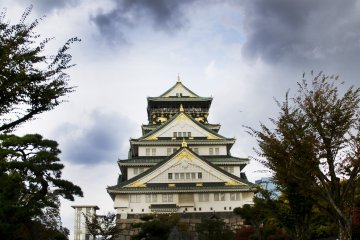
Kastil Osaka kuno dibangun lebih dari 400 tahun yang lalu ketika Jenderal Hideyoshi Toyotomi menyelesaikan kesatuan militer negara. Toyotomi mulai membangunnya pada tahun 1583, butuh waktu dua tahun untuk menyelesaikannya. Namun, kastil ini telah mengalami banyak kejadian. Pada tahun 1598, pemerintah Tokugawa Ieyasu menghancurkan kastil dan kemudian dibangun kembali oleh klan Tokugawa, 40 tahun kemudian kastil itu dibakar. Kastil dibangun kembali pada tahun 1931 berkat sumbangan rakyat. Renovasi besar juga dilakukan pada tahun 1995 untuk mengembalikan baik kastil maupun kemegahan aslinya.

Hampir semua wisatawan memasukan kastil ini ke dalam daftar kunjungan mereka untuk di Osaka. Memang, banyak tempat di Jepang yang indah untuk di kunjungi saat musim gugur, namun Kastil Osaka adalah salah satu yang terbaik.

Di Taman Kastil Osaka, pengunjung dapat menikmati bunga-bunga sakura bersemi di sisi Kastil Osaka yang terkenal. Taman ini memiliki lebih dari 4300 pohon sakura di lahannya!

Osaka Castle is one of the city’s most iconic sites and draws numerous visitors to its spacious park and imposing keep every year. Osaka Castle was first built by warlord Toyoto...

Hotel MyStays Otemae adalah tempat yang sempurna untuk menginap di Osaka, dengan akses subway ke Namba. Hotel ini menawarkan layanan yang baik , termasuk staf yang berbahasa Inggris dan WiFi yang lancar, sebagaimana lokasinya yang sangat baik.

Hotel MyStays Shinsaibashi membuat perjalanan setiap turis sempurna di Osaka. Mengombinasikan indah, nyaman, dan kemudahan, Anda wajib mempertimbangkan untuk menginap di hotel ini dalam perjalanan di kota yang menakjubkan ini.

Berlokasi di dekat aliran Sungai Yodogawa dan 10 menit berjalan dari Stasiun Nishinakajima-minamikata, hostel ini terletak di pinggir Pusat Kota. Menawarkan kedamaian daerah pinggiran tetapi dengan akses cepat ke area utama Osaka, lokasi hostel ini ideal. Bangunan dan Tanggul di depannya juga menawarkan pemandangan luar biasa dibandingkan Kota terdekatnya Tsutenkaku, jadi pastikan untuk pergi jalan-jalan keluar setelah petang dan menikmati hidup di bawah kilauan lampu neon. Kalau anda menginap di Bulan Agustus, anda akan menjadi saksi pertunjukkan kembang api terbesar di Kansai, "Yodogawa Hanabi Taikai"
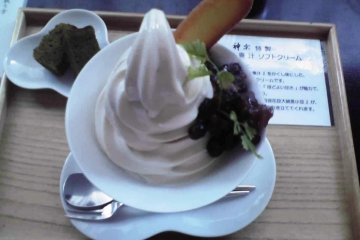
Toko berusia 200 tahun dengan spesialisai Kombu yang menawarkan es krim rumput laut yang di luar dugaan ternyata rasanya sangat lezat!
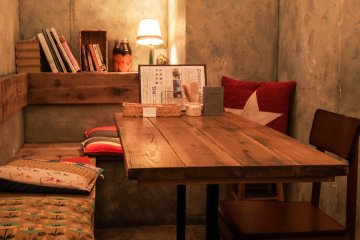
3 restoran vegan terbaik di Osaka, yang mengkhususkan diri pada "karage ayam" dari kedelai, kari kelapa, dan kue keju yang terbuat dari tahu.
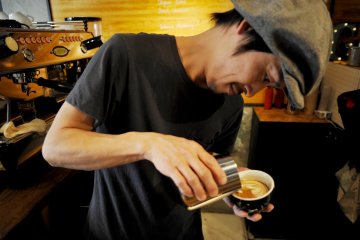
Mengunjungi satu kafe ke kafe lainnya di distrik anak muda Osaka.
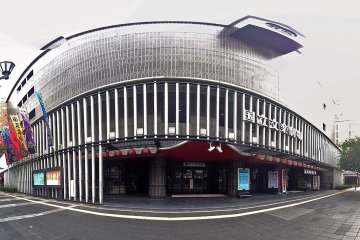
Osaka has been the capital of Bunraku, the traditional Japanese puppet theater, for many centuries. The National Bunraku Theater is a two-hall and exhibition room complex located in Chūō-ku, Osaka. The theater is now one of the few places where where the fascinating art form of bunraku can be seen. The complex opened in 1984 as the country's fourth national theater and became the headquarters of the Bunraku. The National Theater is operated by the Japanese Arts Council, an independent administrative body of the Ministry of Education, Culture, Sports, Science and Technology. English programs and headphones are available. The performances usually take place at three-week intervals in January, April, June, July / August and November.

Kuromon Market, or Kuromon Ichiba, is a staple destination among tourists and residents alike thanks to its abundance of fresh fish, meat, fruits, vegetables, sweets, clothes, and household/ miscellaneous items. The over 170-year old shopping street extends 580-meters long and is home to approximately 150 shops. Peruse large, commercialized shops alongside mom-and-pop spots and immerse yourself in the preserved food culture of Osaka. The lively atmosphere of shoppers, street food vendors, and tantalizing aromas will make for an unforgettable shopping experience. The historic market, officially established in 1902 with the name Enmyoji Ichiba, quickly gained the nickname Kuromon Ichiba, which translates to Black Gate Market, due to the nearby Enmyoji Temple’s renowned black-painted gate. Although the temple was completely destroyed by fire in the early 20th century, the market’s name still persists today. Although Kuromon Market has become a popular tourist destination, it still retains an authentic feel thanks to its local shoppers, cultural offerings, and down-to-earth vibes. The street is full of exciting finds, so be sure to explore them all! Pick up some preserved and pickled vegetables, wasabi root, bamboo shoots, wagyu beef, fugu (blowfish), strawberry daifuku (mochi covered strawberries), anime merchandise, or second-hand kimonos, to name a few. Given that you are surrounded by food, why not try some as well? Thankfully, the market is a hotspot for street food and quick bites on the go. Try some takoyaki, grilled scallops, sushi, oden (assortment of meat skewers, meatballs, fishcake, and daikon radish in a light soy-flavored dashi broth), kushisei (deep-fried meat skewers), okonomiyaki, fresh fruit juice, and so much more. Make sure you come to the market hungry and enjoy Osaka’s cuisine! As you explore the market please be mindful of your trash and support the cleanliness of the area. Towards the southern end of the market is the Kuromon Information Center. The center is a wonderful place to unwind after hours of walking and offers a seating area, toilets, a diaper changing table, a baggage counter, a currency exchange machine, and Chinese- and English-speaking staff onsite.
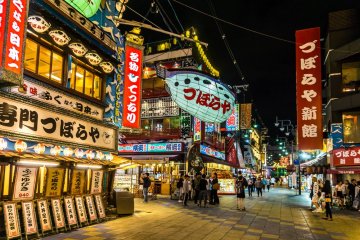
Dotonbori, located along the canal of the same name, is a street in the Namba district of Osaka’s Chuo ward that epitomizes the city’s nightlife. The colorful area is an explosion of neon lights, mouth watering street food, retro vibes, clubs, stores, and bars. A popular saying associated with the street is kuidaore, which roughly means to go bankrupt after spending an enormous amount of money on food. To experience the essence kuidaore (responsibly, of course) be sure to check out this renowned partying spot and lose yourself in the contagious energy! Roots in the 1600s The historic street started in the 1620s as a theater district with kabuki and bunraku (puppet) establishments along the canal. Over the years, many theaters closed as people lost interest in the traditional arts, and unfortunately, most of the remaining theaters were destroyed in bombing raids during WWII. Today, Shochiku-za Theater stands as the only reminder of the street’s theater roots. Today Today, Dotonbori is one of Osaka’s top tourist destinations. When the sun goes down, flashy neon advertisements light up along the canal and streets. The rainbow of colors illuminates the night air, creating an exciting atmosphere that matches Dotonbori’s offerings. Walk along the bustling street and lose yourself in the tantalizing food smells, energetic chatter, and hypnotizing sights. Embrace Kuidaore Food Culture With a phrase like kuidaore associated with the street, there is no doubt that Dotonbori takes its food culture seriously. The street is one of the best places to experience Osaka cuisine, and the area’s flamboyant restaurants themselves are a feast for the eyes. You will need multiple nights to enjoy all of the street’s wonders! For a personalized and unforgettable experience, book a food tour with a local who can guide you through the best spots. Discover Dotonbori's top restaurants. See the Sights! After, while, or before you eat, explore the vibrant area. Seemingly every spot of the street is filled with dazzling lights, historic vibes, and unique charm. Listed below are some of Dotonbori’s staple destinations. Though be sure to explore off of the beaten path and discover the street’s many wonders yourself!